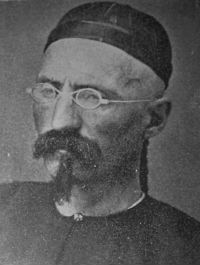The West’s fascination with the giant Panda dates back only to the 19th century, when a French missionary Catholic priest recorded in his journal that he had seen the body of a “white bear” shot by hunters in the Sichuan province of China.
Father Armand David, a member of the Congregation of the Mission founded by St. Vincent de Paul, spent 12 years in China as a missionary, zoologist and botanist. Shortly after he was ordained, the natural history museum of Paris sent him throughout China to collect specimens of hitherto unknown animals and plants.
Père David, as he was known, recorded his first brush with the giant Panda in a journal entry dated March 11, 1869:
“When I was on my way back to the church, I was invited to have a rest in a Mr Li’s home. In his home, I saw the Panda’s skin. It’s big and beautiful, colored black and white,” Père David wrote.“The skin was quite peculiar. Li told me that I would see this animal very soon, for his hunters were going to hunt this animal … it seemed that a new species in the science domain will be found.”
When the hunters returned, two weeks later, Père David described the Panda in his journal:
“The body of the whitebear was all white except that the legs, the ears and the places around its two eyes are black. It has the same skin color as a grown-up bear that I have seen before. I believe it to be a new species, not only because of its skin color, but also because of the hair beneath its feet and other characteristics.”
In the course of his explorations, Père David sent back to Paris specimens of 63 previously unknown animals and 65 birds.

Throughout Armand David’s time working as as a zoologist and botanist in China, he was known for his devotion to his missionary work and his obedience to his order’s duties. Photographs taken of Père David show him wearing traditional Chinese dress, including a close-fitting cap, pigtail and mustache and beard. According to the Catholic Herald, he learned Chinese and worked with native priests to bring the Gospel to the people of China.

